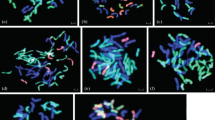Summary
One hexaploid wheat cultivar (Triticum aestivem) and two tetraploid wheat lines (T. durum) were crossed with seventeen inbred lines of rye (Secale cereale). Seed set, degree of hybrid embryo differentiation at the time of excision for in vitro culture and recovery of amphihaploid plantlets from various embryo categories were studied. Degree of embryo differentiation was predominantly determined by maternal wheats, paternal rye genotypes appearing to be of minor importance. T. aestivum x rye hybrid embryos were superior to those produced from T. durum for degree of differentiation. The proportion of plantlets developing from differentiated embryos was high for all wheat parents, whereas undifferentiated embryos were mostly unsuitable for plantlet production. The results revealed that cross-incompatibility in hexaploid wheat x rye crosses was due to failure of fertilization, while in tetraploid wheat x rye crosses it was caused by lack of embryo differentiation. Correlation analyses showed that seed set provided a criterion to predict the amphihaploid plantlets to be expected from a particular wheat x rye combination.
Similar content being viewed by others
References
Bajaj, Y. P. S., K. S.Gill & G. S.Sandha, 1978. Some factors enhancing the in vitro production of hexaploid triticale (Triticum durum x Secale cereale). Crop Improv. 5: 62–72.
Bartlett, M. S., 1947. The use of transformations. Biometrics 3: 39–52.
Bates, L. S. & T. J.Killeen, 1980. Effects of maternal and paternal genotypes on direct Triticum diploid species crosses with Secale species. Cer. Res. Comm. 8: 593–597.
Keyworth, S. & E. N.Larter, 1979. Embryo and endosperm development in wheat-rye hybrids. Cer. Res. Comm. 7: 135–144.
Krolow, K.-D., 1970. Untersuchungen über die Kreuzbarkeit zwischen Weizen und Roggen. Z. Pflanzenzüchtg 64: 44–72.
Moss, J. P., 1970. Endosperm failure and incompatibility in crosses between Triticum and Secale. Chromosomes Today 3: 124–132.
Oettler, G., 1982. Effect of parental genotype on crossability and response to colchicine treatment in wheat-rye hybrids. Z. Pflanzenzüchtg 88: 322–330.
Oettler, G., 1983. Crossability and embryo development in wheat-rye hybrids. Euphytica 32: 593–600.
Snedecor, G. W. & W. G.Cochran, 1967. Statistical methods. The Iowa State University Press, Ames, Iowa.
Tanner, D. G. & D. E.Falk, 1981. The interaction of genetically controlled crossability in wheat and rye. Can. J. Genet. Cytol. 23: 27–32.
Taira, T., T.Lelley & E. N.Larter, 1978. Influence of parental rye on the development of embryos and endosperm of wheat-rye hybrids. Can. J. Bot. 56: 386–390.
Author information
Authors and Affiliations
Rights and permissions
About this article
Cite this article
Oettler, G. Parental effects on crossability, embryo differentiation and plantlet recovery in wheat x rye hybrids. Euphytica 33, 233–239 (1984). https://doi.org/10.1007/BF00022771
Received:
Issue Date:
DOI: https://doi.org/10.1007/BF00022771



